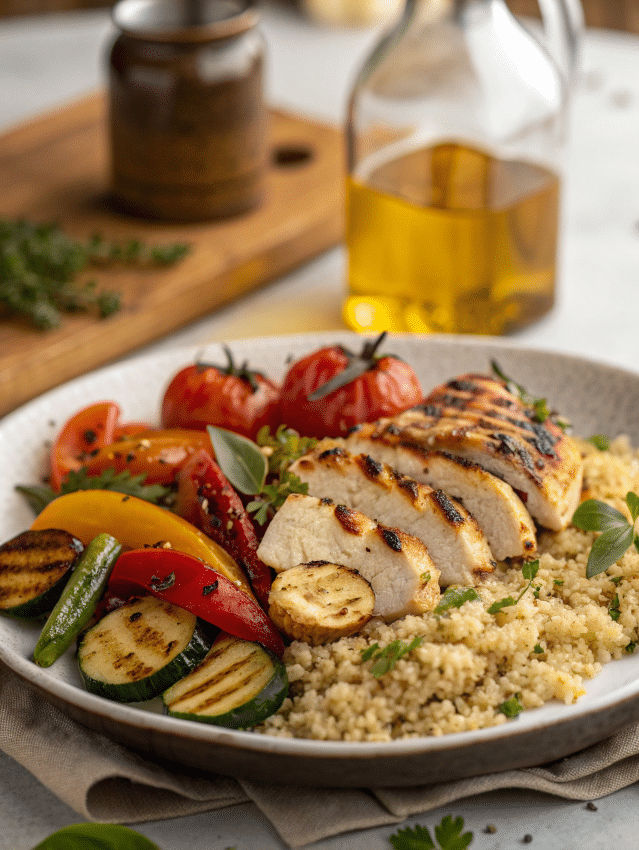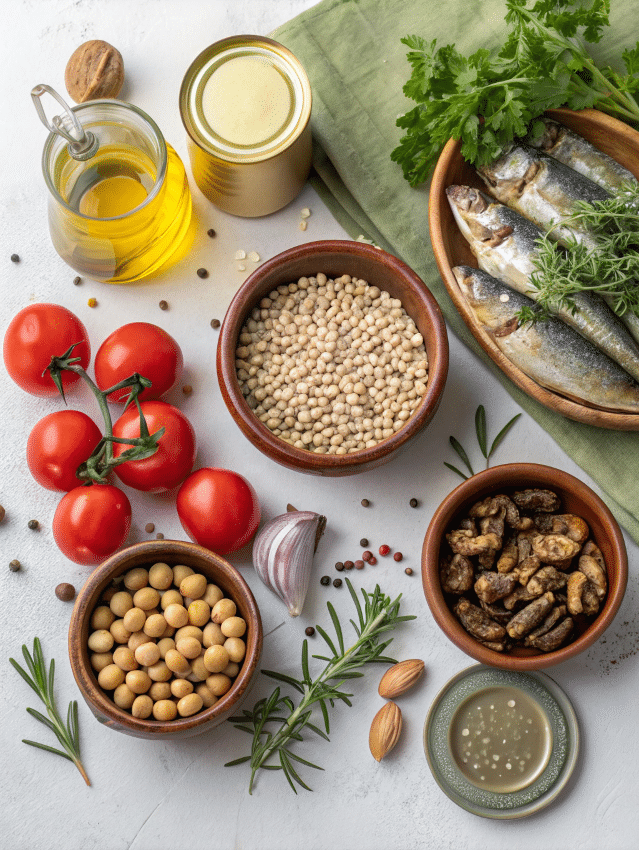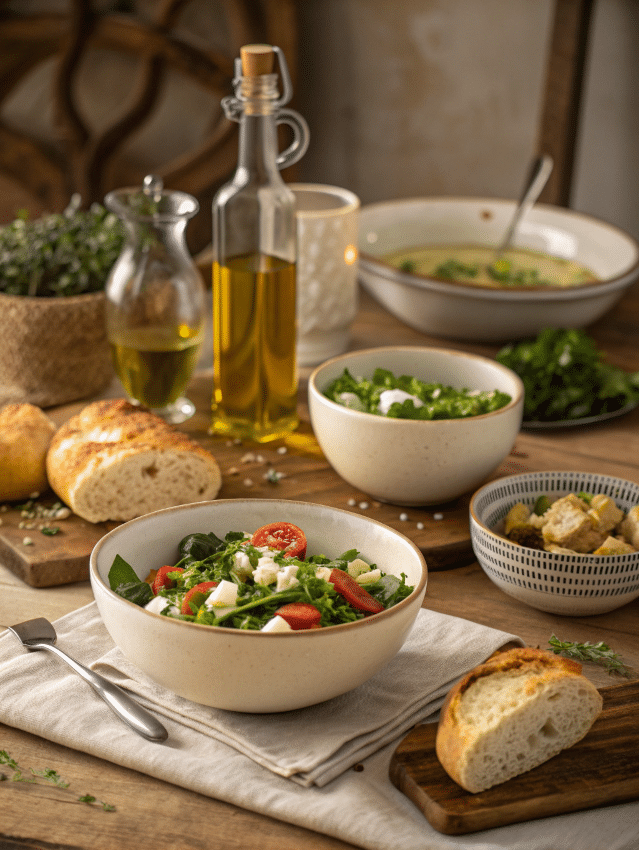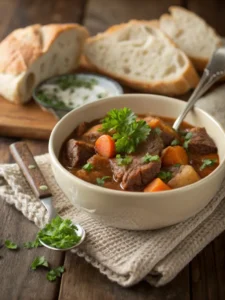
What is the Mediterranean Diet? It’s more than a trend, it’s a way of eating rooted in the coastal kitchens of Greece, Italy, and Spain. This heart-healthy lifestyle emphasizes fresh vegetables, fruits, olive oil, fish, and whole grains. Unlike strict meal plans, the Mediterranean diet is flexible, flavorful, and backed by decades of research. Whether you’re trying to eat better, feel more energized, or just enjoy real food again, this guide will walk you through everything you need to know, from what to eat, what to avoid, and how to make it all delicious.
In this Article
Key Takeaways: What You Need to Know
- The Mediterranean diet is inspired by the traditional eating patterns of countries bordering the Mediterranean Sea, like Greece, Italy, and Spain.
- It emphasizes whole, minimally processed foods like vegetables, fruits, olive oil, whole grains, fish, and legumes.
- Scientific studies have shown this diet supports heart health, longevity, and weight balance.
- It’s not a rigid meal plan, it’s a flexible, flavorful, and sustainable lifestyle.
- This article breaks it down clearly with personal insight, real food ideas, and answers to your biggest questions.
What Is the Mediterranean Diet – The Story & Intro
What is the Mediterranean Diet? It’s a flavorful and sustainable way of eating based on the traditional habits of countries like Greece, Italy, and coastal Spain. It’s not about restriction, it’s about joyfully embracing real, wholesome ingredients. As a home cook in Austin, I first got inspired after a trip to the Greek Isles. The food was simple but rich with flavor: fresh fish grilled with lemon, vine-ripened tomatoes drizzled with olive oil, and bread torn straight from a loaf, no calorie counting, no guilt.
When I got home, I started cooking that way: fewer processed foods, more plants, and always a drizzle of extra virgin olive oil. Over time, this approach transformed how I felt, less bloated, more energetic, and genuinely excited to cook again.
At its core, the Mediterranean Diet is about balance. You’ll find fish instead of fried chicken, olive oil instead of butter, and fresh herbs instead of bottled sauces. Wine isn’t forbidden. Neither is bread. What makes this lifestyle work is its flexibility and freshness, and the way it reconnects you to food in a meaningful, mindful way.
If you’re new to this, don’t worry. You don’t need to live near the Aegean Sea to enjoy it. From Austin to anywhere, you can start building your Mediterranean pantry with common items like beans, canned tuna, olive oil, herbs, and whole grains.
On WeTasteRecipes.com, I’ve created recipes and guides that make it easy to start today, like this Mediterranean Diet Recipes collection with real, budget-friendly meals.
Let’s move on to the basics, what exactly makes this way of eating so powerful, and how it supports long-term health better than any diet you’ve tried before.
Mediterranean Diet Basics & Health Benefits

When people ask what is the Mediterranean Diet, the answer starts with a simple truth: it’s a lifestyle, not a diet in the traditional sense. There are no complicated rules, no apps required, and no off-limit food groups. Instead, this eating pattern comes from the time-tested traditions of countries bordering the Mediterranean Sea, places where food is fresh, seasonal, and meant to be enjoyed, not tracked.
The Core Principles of the Mediterranean Way
So, what is the Mediterranean Diet really built on? Whole, unprocessed foods. Meals focus on vegetables, fruits, legumes, whole grains, nuts, seeds, herbs, and olive oil. Fish and seafood are enjoyed a few times a week, while poultry, eggs, cheese, and yogurt are eaten in moderation. Red meat and sweets? Only occasionally.
The main source of fat is extra virgin olive oil, a heart-healthy, antioxidant-rich fat that replaces butter or vegetable oils. Herbs and spices add bold flavor, so you rarely need sugar or salt-heavy sauces. Meals are often shared with family or friends, enjoyed slowly, and served with a small glass of red wine.
Proven Health Benefits Backed by Science
If you’ve been wondering what is the Mediterranean Diet good for, the answer is: quite a lot. According to research by the National Institutes of Health, this eating pattern is linked to lower risk of heart disease, stroke, type 2 diabetes, cognitive decline, and even some cancers. It supports gut health, reduces chronic inflammation, and can promote healthy weight management.
Unlike restrictive fad diets, the Mediterranean approach is sustainable and satisfying. In fact, it’s been ranked consistently as one of the world’s healthiest ways to eat by nutrition experts and global health organizations.
To see how this all plays out in real life, check out my Mediterranean Diet Meal Plan, it’s packed with ideas for breakfast, lunch, and dinner using simple pantry ingredients.
Whether you’re here for heart health, better energy, or just wondering what is the Mediterranean Diet that everyone’s raving about, the benefits speak for themselves.
What You Can and Can’t Eat on the Mediterranean Diet
To truly understand what is the Mediterranean Diet, you need to look at what’s on the plat, and just as importantly, what isn’t.
This isn’t a diet of deprivation. It’s a return to real food: meals that are vibrant, simple, and built around whole ingredients. But like any successful eating style, it helps to know which foods to lean into and which to limit.
What Exactly Do You Eat on a Mediterranean Diet?
If you’re asking what is the Mediterranean Diet meal plan, here’s the short answer: plant-forward, flavorful, and flexible.
You’ll eat plenty of:
- Fresh vegetables and leafy greens
- Fruits (especially berries, citrus, grapes)
- Whole grains like farro, bulgur, brown rice, and oats
- Legumes: lentils, chickpeas, white beans
- Healthy fats like olive oil, nuts, and seeds
- Seafood (2–3 times per week)
- Herbs, garlic, and spices for flavor
Dairy like Greek yogurt and cheese are okay in moderation. Poultry, eggs, and wine appear occasionally, not daily.
Here’s a quick guide that shows the balance:
| Eat Often | Eat Occasionally | Avoid |
|---|---|---|
| Vegetables, legumes, olive oil | Dairy, eggs, poultry, wine | Processed foods, soda, red meat |
If you want a full list to print and save, check out this helpful Mediterranean Diet Food List, it’s a great way to start shopping and meal planning with confidence.
What You Should Avoid or Limit
Understanding what is the Mediterranean Diet also means recognizing what it’s not. This eating pattern limits:
- Processed snacks and fast food
- Added sugars and sugary drinks
- Refined grains like white bread and regular pasta
- Red and processed meats
- Trans fats, margarine, and commercial baked goods
Instead of thinking in terms of “off-limits,” the Mediterranean mindset is to crowd out the bad by loading up on the good. When your plate is full of roasted veggies, hummus, whole grains, and herbs, you won’t miss the drive-thru.
And yes, if you’re wondering “Are potatoes okay?”, the answer is yes in moderation. Prefer roasted or boiled with olive oil and herbs over fried or butter-laden versions.
If you’re still asking yourself what is the Mediterranean Diet, remember it’s about what you eat most of the time, not every single bite. Flexibility is key to why it works so well long-term.
To learn more about the roots of this diet, the Wikipedia article on the Mediterranean Diet provides helpful historical and cultural context.
Mediterranean Meals in Real Life
If you’re still wondering what is the Mediterranean Diet in everyday life, this is where it gets exciting. Because it’s not just about ingredients, it’s about how you build your plate, your day, and even your mindset around food.
Unlike restrictive plans, what is the Mediterranean Diet offers flexibility. It adapts easily to your lifestyle. Whether you’re cooking at home in Texas or grabbing groceries on a busy schedule, Mediterranean meals are satisfying, simple, and deeply flavorful.
What Is a Typical Mediterranean Breakfast?
To understand what is the Mediterranean Diet morning routine, picture this: breakfast that’s light, nutrient-rich, and satisfying, not sugar-loaded or processed.
A typical Mediterranean breakfast includes:
- Greek yogurt with honey, walnuts, and berries
- Whole grain toast with olive oil and sliced tomatoes
- Hard-boiled eggs with cucumbers and olives
- Herbal tea or black coffee, no sugar needed
No sugary cereal or drive-thru donuts here. The focus is on balance and quality fats to keep you full. You’ll also find that breakfast doesn’t have to be huge, just energizing.
For more meal examples, my Mediterranean Diet Meal Plan breaks down a full day of eating, from breakfast through dinner.
What a Mediterranean Plate Looks Like (Lunch & Dinner)
Now let’s get to the real heart of what is the Mediterranean Diet: your main meals. A classic lunch or dinner includes:
- Grilled fish or chickpeas with sautéed greens
- A large vegetable-forward salad with olive oil and lemon
- Whole grains like farro, quinoa, or barley
- A small glass of red wine (optional)
Snacks may be olives, nuts, or a slice of fruit with cheese. Dessert? Maybe fresh figs or a square of dark chocolate.
Get inspired with my full Mediterranean Diet Recipes collection, all beginner-friendly and flavor-packed.
The beautiful thing about what is the Mediterranean Diet is that it doesn’t demand perfection, it celebrates eating with intention. The more meals you build around these principles, the better your body and mind will feel.
Mediterranean Pantry Staples
To fully answer what is the Mediterranean Diet, we have to talk about your kitchen. Because Mediterranean eating starts with smart ingredients, not fancy techniques or hard-to-find superfoods. A well-stocked pantry is the secret behind every quick, delicious, and healthy meal.
The beauty of what is the Mediterranean Diet is how accessible it really is. Most of the staples are already in your grocery store, maybe even in your kitchen right now.
Your Go-To Mediterranean Grocery List
Here’s a pantry blueprint for anyone wondering what is the Mediterranean Diet pantry setup:
Oils & Condiments
- Extra virgin olive oil (your #1 cooking fat)
- Red wine vinegar
- Lemon juice
- Dijon mustard
Grains & Legumes
- Brown rice, quinoa, whole wheat pasta, oats
- Chickpeas, lentils, white beans
Canned Items
- Tuna, sardines, or mackerel (packed in olive oil)
- Diced tomatoes
- Olives, artichokes
Spices & Herbs
- Garlic, oregano, basil, cumin, cinnamon
- Fresh parsley or dill (optional but great)
Nuts & Seeds
- Almonds, walnuts, pine nuts, chia
For a full ingredient-based approach, check out my Celtic Salt Trick, a natural way to enhance flavor without overdoing salt.
How to Build a Mediterranean-Inspired Kitchen
So now that you know what is the Mediterranean Diet made of, let’s make it real in your home. Keep olive oil front and center. Swap processed snacks for dried fruits and nuts. Replace butter with hummus or avocado. Use herbs instead of bottled sauces.
Don’t worry if you can’t buy everything at once. Start small: one new grain, one new bean, one new habit. Even adding canned sardines or Greek yogurt to your rotation counts.
That’s the magic of what is the Mediterranean Diet, it’s forgiving, flexible, and focused on progress, not perfection.
Understanding what is the Mediterranean Diet isn’t just about food. It’s about how your pantry, habits, and choices reflect a better way to live, one meal at a time.
Conclusion & Get Started Today

By now, the answer to what is the Mediterranean Diet should feel clear, it’s not just a way to eat; it’s a way to live better. With every olive oil-drizzled salad, roasted veggie bowl, or herbed fish dish, you’re making choices that support your heart, your energy, and your connection to real food.
What makes this eating style so powerful is its simplicity and flexibility. You don’t need to move to Greece or buy imported ingredients. You can start right now, right where you are, with a few pantry staples and an open mind.
So, what is the Mediterranean Diet step one? Begin with vegetables. Then add legumes, grains, herbs, and healthy fats. Choose fish or beans over fried meats. Make meals slow and social when you can.
Still unsure? My Mediterranean Diet overview is the perfect place to get inspired with beginner-friendly recipes and real-world examples.
If you’re asking what is the Mediterranean Diet best known for, it’s the joy of eating real food without guilt. No counting carbs. No skipping meals. Just balance, flavor, and real nourishment.
The most important thing to remember is that what is the Mediterranean Diet isn’t a perfect formula. It’s a lifelong shift toward healthier, fresher, and more intentional eating. And once you start, your body (and taste buds) will thank you.
Common Questions Answered (FAQs)
You’ve probably searched what is the Mediterranean Diet more than once and still found yourself asking new questions. That’s normal, this lifestyle is flexible, and everyone approaches it a little differently. Here are answers to some of the most asked questions, all grounded in real-life experience and evidence-based guidance.
What Exactly Do You Eat on a Mediterranean Diet?
If you’re still wondering what is the Mediterranean Diet food list, think plants, fish, and flavor.
Here’s what you’ll eat regularly:
Colorful vegetables like zucchini, eggplant, tomatoes
Fruits like berries, oranges, and grapes
Whole grains: bulgur, farro, brown rice, oats
Legumes like chickpeas and lentils
Healthy fats from olive oil, nuts, and seeds
Fish, seafood, and occasional poultry
Fermented dairy like yogurt and aged cheese
Red wine in moderation (optional)
This is what sets what is the Mediterranean Diet apart, it isn’t restrictive. You eat well and feel full without obsessing over numbers. Visit our Mediterranean Diet Food List for a detailed printable guide.
What Is a Typical Mediterranean Breakfast?
A Mediterranean breakfast is light but nourishing, another reason people ask what is the Mediterranean Diet and why it works so well.
Examples include:
Greek yogurt with figs and walnuts
Hard-boiled eggs with olives and tomatoes
Whole grain toast with hummus or avocado
Herbal tea or black coffee (skip the sugar)
There’s no need for sugary cereals or heavy pastries. The simplicity of these breakfasts is a key reason what is the Mediterranean Diet appeals to people with busy lives.
What Can I Not Eat in a Mediterranean Diet?
Understanding what is the Mediterranean Diet also includes knowing what to avoid or limit.
Here’s what to reduce:
Processed snacks and fast food
Refined grains (white rice, white bread)
Sugary beverages
Red meats and cured meats
Trans fats, margarine, and excess butter
Instead, fill your plate with fresh, whole ingredients. Mediterranean eating is about enjoying more of the good, not obsessing over cutting things out.
Are Potatoes OK on a Mediterranean Diet?
Yes, and this surprises many people asking what is the Mediterranean Diet standard. Potatoes, especially when roasted or boiled with herbs and olive oil, fit beautifully into Mediterranean meals.
Avoid frying or slathering them in butter. Use them the way they’re enjoyed in Greece or Spain, as part of a dish, not the main event. Pair them with beans or fish and you’ve got a perfect example of what is the Mediterranean Diet looks like on your plate.


